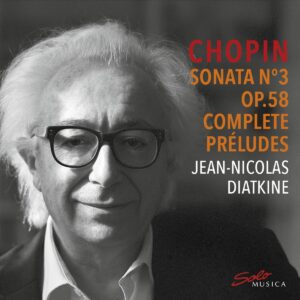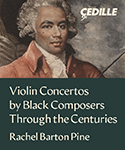Jean-Nicolas Diatkine’s decisive launch into the Chopin B minor sonata’s opening movement signifies the fluent and contrapuntally astute reading to follow. The pianist’s forward momentum and sense of continuity avoid making the exposition repeat sound superfluous, especially in how he honors the D major second theme’s sostenuto marking without gilding the proverbial lily. The Scherzo’s sedate and generously pedaled outer sections conflict with Chopin’s Molto vivace and leggiero indications, yet Diatkine’s phrasing still conveys shape and direction.
I find the Largo movement refreshingly forthright and unsentimental, although some may miss the sustained breadth of Gilels or Arrau. The Finale conveys plenty of power and excitement, along with Diatkine’s astute attention to bass lines. Pianists tend to treat the accompaniment as a backdrop when the main theme appears in E minor (about 1:37 into the movement in this recording). However, Diatkine is one of the few to bring out and clarify the left hand’s four eighth notes against the right hand’s three.
Diatkine’s Chopin Preludes contain many vividly characterized and texturally arresting moments. Right off the bat, your ears will perk up at the first Prelude’s freedom and swing, plus No. 2’s stinging dissonances and soaring melody line. Also note Diatkine’s subtle voice leading in No. 4’s steadily murmuring left-hand chords, his patient unfolding of No. 5’s cross-rhythmic phrases, and a Prelude No. 8 that makes its points through careful delineation rather than sweeping ferocity.
In contrast to pianists like Maurizio Pollini who play No. 9’s controversial dotted eighth- and 16th-note pattern to conform with the accompanying triplet, Diatkine plays it as written, but his tendency to rush undermines the effect, while No. 10 is similarly unsteady. His slow, subjective, and liberally pedaled No. 14 leads into a thankfully brisk and flexible “Raindrop” Prelude (No. 15). However, the pedal becomes more of a crutch than a tool in No. 16. No. 21 evokes Alfred Cortot’s rhapsodic spontaneity, while intriguing dynamic inflections further intensify No. 22’s tumultuous exchanges between the hands. Diatkine includes the two non-Op. 28 Preludes as well.
I’ve often written about how the left-hand accompaniment’s register crossings throughout Chopin’s C-sharp minor Prelude Op. 45 evoke something similar in Brahms’ Capriccio Op. 76 No. 1. Diatkine’s interpretation underscores that connection, if not with the rapture of Cortot, Arrau, Michelangeli, and Pogorelich. Quibbles aside, Diatkine is obviously a seasoned and experienced Chopin interpreter with much to offer.
































